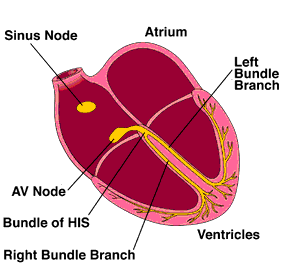HeartPoint animation: this will take approximately 1 minute and 45 seconds to load.

ARRHYTHMIAS - GENERAL
HeartPoint animation: this will take approximately 1 minute and
45 seconds to load.

Disorders of the regular rhythmic beating of the heart is one of the most common disorders seen in the practice of cardiology. Irregular rhythms can be minor annoyances, or may indicate a serious problem. Arrhythmias may indicate an underlying abnormality of the heart muscle, valves or arteries. They can also take place in a healthy heart, and be of minimal consequence.
The heart has its own system for initiating and propagating the electrical impulse to every part of the heart muscle at the right time. This process is depicted graphically above. The technical details follow for those who are interested. The "sinus node" is found in the right atrium and is therefore the "pacemaker". This tissue begins the process of "depolarization", the event where charged molecules ("ions") move across the cell membrane to begin the electrical impulse which will travel to the rest of the heart. The two upper chambers (the left and right atria) then depolarize, causing them to contract and fill the lower chambers (the left and right ventricles) with blood. The electrical impulse must be slowed down before proceeding to the ventricles to wait for the slower mechanical event of atrial contraction to complete. This occurs in the "AV Node" (the atrioventricular node) that lies between the upper and lower chambers of the heart. Once sufficient time has elapsed, the impulse leaves the AV Node and travels down specialized electrical "bundles" designed to bring the impulse to the large amount of ventricular muscle in a prompt and organized fashion. The "bundle of His" (named after an early investigator) splits into the right and left bundle branches. The left bundle splits further into anterior and posterior "fascicles". The ventricles contract, and the whole process starts again.
The heart has to be able to beat slowly at times, for example when we're asleep so that it doesn't waste energy. But, it also needs to beat fast to supply all of the other muscles with oxygen when you're running from a saber-toothed tiger. There are fibers in the heart that do one or the other of these things who live very close to one another. These differing electrical properties can allow "short circuits", even in the normal heart. In patients with heart disease, there may be areas that may initiate too many impulses. In other cases the heart may not beat fast enough. One or more of these mechanisms may be involved in a particular pattern of irregular heart beating. To learn more about this common and challenging area, read on. ©COPY 1997 HeartPoint Updated October 1997
Also see these related topics:
Arrhythmias - General Considerations Arrhythmias - Specific Pacemakers Atrial fibrillation Ventricular arrhythmias
| Commentary |
Food You Will Love | HeartPoint
Gallery | In The News | Health Tips | What's New
|
| Information Center | Home
|
This site presents material for your information, education and entertainment. We can assume no liability for inaccuracies, errors, or omissions. Above all, material on this site should not take the place of the care you receive from a personal physician. It is simply designed to help in the understanding of the heart and heart disease, and not as a diagnostic or therapeutic aid. You should seek prompt medical care for any specific health issues. Please feel free to browse the site and download material for personal and non-commercial use. You may not however distribute, modify, transmit or reuse any of these materials for public or commercial use. You should assume that all contents of the site are copyrighted. ©COPY;1997 HeartPoint